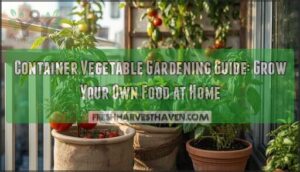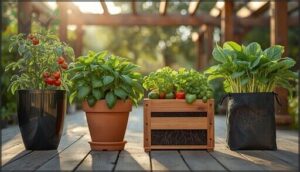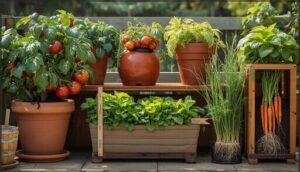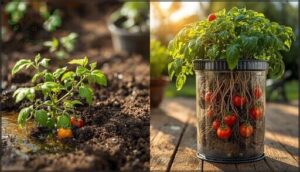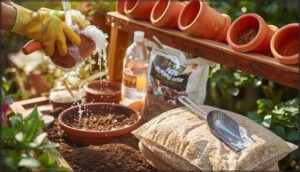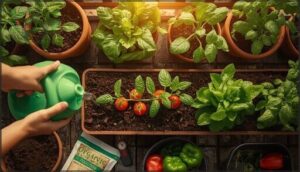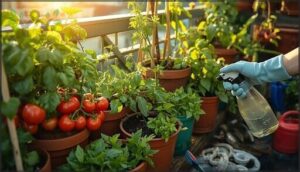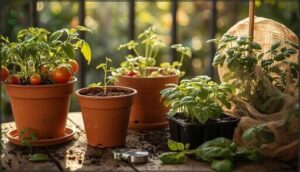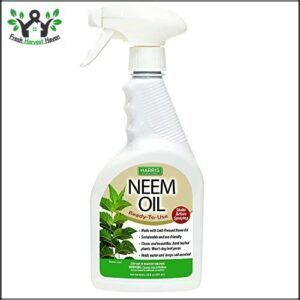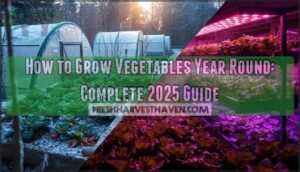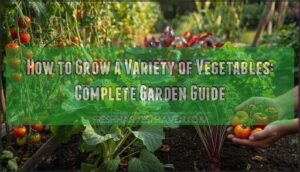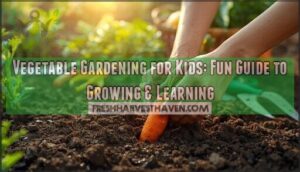This site is supported by our readers. We may earn a commission, at no cost to you, if you purchase through links.
A single balcony can yield over 40 pounds of fresh vegetables per season—no backyard required. Container vegetable gardening transforms any sunny spot into productive growing space, whether you’re working with a fire escape, patio, or windowsill.
Urban growers are reclaiming square footage with vertical setups and compact varieties that outperform traditional gardens in yield per square foot.
The key lies in matching container size to root depth, selecting potting mix with proper aeration, and timing your water schedule to soil moisture levels. Master these fundamentals, and you’ll harvest tomatoes, peppers, and greens from spaces you never thought could support a garden.
Table Of Contents
- Key Takeaways
- Benefits of Container Vegetable Gardening
- Choosing The Best Containers for Vegetables
- Selecting Vegetables for Container Success
- Soil, Watering, and Fertilization Essentials
- Planting, Maintenance, and Pest Control
- Top 5 Products for Container Vegetable Gardening
- Frequently Asked Questions (FAQs)
- Can container gardens work in winter months?
- How often should containers be replaced yearly?
- What fertilizer schedule works best for containers?
- Can you grow perennial vegetables in containers?
- How do you prevent containers from overheating?
- Can containers be reused for multiple seasons?
- What winter storage options work for containers?
- How do you prevent containers from freezing?
- Can you grow vegetables indoors year-round?
- Whats the container garden startup cost?
- Conclusion
Key Takeaways
- Container vegetable gardening can produce over 40 pounds of fresh produce per season from a single balcony by matching container size to root depth requirements (5+ gallons for tomatoes, 2+ gallons for greens) and using quality potting mix with perlite or vermiculite for proper aeration.
- Success hinges on three fundamentals: selecting containers with adequate drainage holes and 12-18 inches of soil depth, maintaining consistent moisture through deep watering when the top inch feels dry, and fertilizing every 1-3 weeks since frequent watering accelerates nutrient depletion.
- Strategic plant selection maximizes yields—dwarf varieties like ‘Red Robin’ tomatoes and ‘Spacemaster’ cucumbers deliver 25% more harvests per square foot than traditional plantings, while companion planting combinations (tomatoes with basil, pole beans over lettuce) reduce pest populations by up to 58%.
- The upfront investment of $10-30 per container pays off through substantial grocery savings, with a single tomato plant turning a $13 investment into $80 worth of produce and herbs saving 50-90% compared to store prices throughout the growing season.
Benefits of Container Vegetable Gardening
Container gardening puts fresh vegetables within your reach, even if you don’t have a traditional garden plot. You can grow a surprising variety of crops in pots, planters, and other vessels without needing acres of land.
Let’s look at the key advantages that make container vegetable gardening worth your time and effort.
Space-Saving Advantages for Small Areas
Even in a cramped apartment, you can access productive growing space through strategic container gardening. Urban farmers report reclaiming up to 10 square feet on a single balcony, while vertical gardening boosts yields by over 40%. Compact gardening methods like stackable planters and trellises transform windowsills and patios into thriving small space gardens. Dwarf varieties deliver 25% more harvests per square foot than traditional plantings.
By utilizing small space gardens, individuals can make the most of their available area for planting.
Flexibility in Sun and Temperature Management
Containers release true sunlight optimization—you can wheel your tomatoes toward full sun or tuck lettuce under shade cloth when temperatures spike. This mobility lets you master microclimate management and seasonal adaptation, chasing that essential 6–8 hours of light fruiting crops demand.
Temperature control becomes simple: slide pots indoors before frost or shift them to cooler zones during heat waves, building genuine climate resilience into your growing strategy.
By understanding container gardening, you can create a thriving and adaptable garden.
Reducing Grocery Costs With Homegrown Produce
Your vegetable garden delivers real cost savings—a single tomato plant yields 10 to 30 pounds of fresh produce, slashing grocery bills with homegrown vegetables worth $80 from a $13 investment in seeds and compost.
A single tomato plant can turn a $13 investment into $80 worth of fresh produce, delivering real savings on your grocery bills
Container vegetable gardening turns budget gardening into home harvesting mastery: herbs save you 50–90% over store prices, while growing vegetables in pots creates practical grocery alternatives that pay dividends all season.
Accessibility for Beginners and Urban Gardeners
Beyond savings, container vegetable gardening creates opportunities for anyone keen to grow food—no yard required. Urban gardeners transform balconies into productive spaces, while beginners master small-scale setups before expanding. Adaptive tools and raised planters make gardening accessible regardless of mobility, and clean containerized soil sidesteps urban contamination.
- Mobile containers maximize sun exposure in tight urban spaces
- Raised planters eliminate bending for accessible gardening comfort
- Beginner-friendly techniques yield 70% success rates in containers
- Lightweight tools and self-watering designs reduce physical demands
- Community workshops provide essential container gardening tips and support
Choosing The Best Containers for Vegetables
You can’t just grab any pot and expect your vegetables to thrive. The material, size, and drainage of your container directly influence root development, water retention, and overall plant health.
Let’s break down what works and why, so you can set up your containers for real success.
Comparing Container Materials (Plastic, Clay, Wood, Fabric)
Your choice in container materials directly impacts root health and harvest success. Plastic pots offer low material costs but heat soil rapidly, while ceramic pots provide better soil temperature control at the expense of container durability. Fabric pots excel in water retention balance and prevent root circling, and wooden containers deliver stable insulation.
Each material influences how your vegetables access oxygen and moisture.
Selecting The Right Size and Shape for Each Crop
Root space determines how your vegetables perform in containers. Most vegetables need at least 5-gallon pots with 12 to 18 inches depth—tomatoes, peppers, and eggplants thrive here. Salad crops and shallow-rooted leafy greens succeed in 1 to 3 gallons.
Soil volume directly affects crop selection: carrots need 10-inch diameter containers, while cucumbers require 10+ gallons. Plant geometry matters less than total container sizes for yield.
Importance of Drainage and Soil Depth
Without proper drainage holes, your container becomes a swamp—roots suffocate and rot sets in fast. Soil depth matters just as much: shallow pots restrict root growth and cut yields by 22–35%. Aim for 12–18 inches minimum for most vegetables.
Adequate drainage and depth together boost oxygen flow, strengthen root health, and boost your harvest dramatically.
Preparing Containers for Planting Success
Before you drop a single seed, clean and sanitize your container to stop disease before it starts. Scrub away old soil and debris, then rinse with a 50–150 ppm bleach solution and air dry completely.
Proper container preparation and soil sterilization cut disease transmission and set your drainage systems up for success.
Your prep checklist:
- Remove all residue – roots, potting mix, and buildup harbor pathogens
- Scrub with detergent – physical cleaning comes before sanitizing
- Apply bleach solution – let it air dry in a clean zone
- Use sterile potting mix – soilless blends with perlite or vermiculite prevent weeds
- Pre-moisten media thoroughly – aim for 45–60% container volume before planting
Selecting Vegetables for Container Success
Not every vegetable adapts well to container life, so you’ll want to choose crops that thrive in confined root zones and limited soil volume. Your success depends on matching plant needs to container conditions—root depth, growth habit, and nutrient demands all matter.
The varieties below represent proven performers that won’t just survive but actually produce substantial harvests in pots and planters.
Top Vegetable Varieties for Pots and Planters
You can’t go wrong starting your vegetable garden with these proven performers. Compact tomatoes like ‘Patio Princess’ produce ripe fruit in 60–70 days, while leafy greens such as lettuce and spinach mature in just 40–50 days. Pepper varieties and root crops like ‘Romeo’ carrots thrive in pots, and vertical gardening with bush beans maximizes your space—growing vegetables in containers has never been easier.
| Crop Type | Container Size | Days to Harvest |
|---|---|---|
| Cherry Tomatoes | 5+ gallons | 60–70 days |
| Lettuce & Greens | 2+ gallons | 40–50 days |
| Peppers | 3–5 gallons | 75–90 days |
Best Dwarf and Miniature Vegetable Options
Dwarf varieties transform even the tiniest balcony into a productive urban harvest zone. You’ll love ‘Red Robin’ tomatoes—they mature in just 55 days and stay under 3 feet tall. ‘Patio Baby’ eggplants reach only 12 inches, while ‘Spacemaster’ cucumbers thrive in hanging baskets.
These miniature vegetables need less fertilizer and deliver multiple harvests per season, making your container gardening incredibly efficient.
Companion Planting Strategies in Containers
You can squeeze more harvest from your container vegetable garden using strategic planting combinations. Pairing tomatoes with basil or planting tansy alongside potatoes cuts pest populations by up to 58%.
Vertical gardening with pole beans over lettuce doubles your yield without expanding footprint.
These companion planting partnerships reduce fertilizer needs by 19% while supporting beneficial insects and creating productive microclimates.
Indoor Herbs and Edibles for Containers
Move your container vegetable garden indoors and you’ll access year-round harvests with minimal space. Basil produces 0.5–1 ounce weekly under 14–16 hours of grow lights, while mint regenerates at 80–90% per cycle.
Master indoor herb gardening success with:
- Herb Selection: Choose basil, chives, mint, and parsley for consistent yields in 6-inch pots
- Indoor Lighting: Provide 6–8 hours direct sun or supplement with fluorescent fixtures
- Container Materials: Use fabric pots with drainage for 25% better root health
Soil, Watering, and Fertilization Essentials
You’ve picked your containers and chosen your vegetables—now it’s time to set them up for success. The right potting mix, watering routine, and fertilizer schedule make the difference between a struggling plant and a thriving harvest.
Let’s walk through the essentials that’ll keep your container vegetables healthy from planting to plate.
Choosing Quality Potting Mix and Amendments
Your container vegetable garden will only thrive if you start with quality potting mix—not garden soil. Look for fluffy, well-draining blends containing perlite, vermiculite, aged bark, and sphagnum peat moss. These amendments guarantee proper aeration and moisture retention. Avoid mixes with heavy sedge peat or actual dirt.
A balanced container gardening soil and potting mix composition sets the foundation for nutrient management and successful fertilizing throughout the season.
Watering Schedules and Techniques for Containers
Water your containers when the top inch or two of soil feels dry—often daily in hot weather or twice if temperatures climb above 77°F. Water deeply until 5–10% drains from the bottom; this encourages strong roots and boosts water efficiency.
Add mulch to shade soil and cut evaporation.
For drought management, place containers in partial shade during peak heat.
Fertilizing for Optimal Vegetable Growth
Frequent watering accelerates nutrient cycling in containers, so fertilizing container gardens demands consistent attention. Apply a balanced fertilizer—like 10-20-10—every two to four weeks, or use slow-release fertilizer at planting with biweekly liquid supplements.
Organic fertilizer options include fish emulsion and kelp, which strengthen micronutrient balance.
For fruiting crops, tomato-specific formulas maximize yield, while monitoring soil pH management and organic supplements prevents deficiencies common in restricted root zones.
Maintaining Soil Moisture and Health
Consistent moisture management separates thriving container gardens from struggling ones. Balance water retention with soil aeration by monitoring these critical factors:
- Check moisture 1–2 inches below the surface using your finger—not just at the top layer
- Verify drainage holes prevent waterlogging that suffocates roots
- Add mulch to reduce evaporation and stabilize soil composition
- Use potting mix with perlite or vermiculite for ideal root health
Deep watering beats frequent shallow applications every time.
Planting, Maintenance, and Pest Control
Getting your vegetables into containers is just the beginning—you’ll need to master the art of ongoing care to keep them thriving. From proper planting techniques to managing unwanted pests, each step plays a role in your harvest success.
Here’s what you need to know to maintain healthy, productive container vegetables throughout the growing season.
Step-by-Step Container Planting Guide
Getting your hands dirty starts with smart container preparation. Fill each pot about ¾ full with quality potting mix, then gently loosen seedling roots before transplanting. For seed sowing, follow packet depth instructions carefully. Firm soil around roots to eliminate air pockets, keeping the surface an inch below the rim for easier watering.
Choose container sizes that match your vegetables’ root systems—cramped roots mean stunted growth and disappointing harvests.
| Container Sizes | Best Vegetables | Soil Depth Needed |
|---|---|---|
| 3-gallon pots | Herbs, lettuce, spinach | 8-10 inches |
| 5-gallon containers | Tomatoes, peppers, eggplant | 12-14 inches |
| 12+ inches deep | Carrots, radishes, potatoes | 12-18 inches |
| Wide shallow | Leafy greens, strawberries | 6-8 inches |
| Large planters | Multiple companion plants | 10-16 inches |
Supporting and Pruning Container Vegetables
Vertical support transforms your container garden from chaotic sprawl into productive vertical real estate. Install stakes, trellises, or cages when transplanting—not after roots have settled—to avoid root damage. Pruning techniques focus plant energy where you want it: on fruit, not excess foliage.
- Use bamboo stakes or wire cages for tomatoes and peppers to prevent fruit rot
- Prune tomato suckers regularly to increase fruit size by 14%
- Train vining crops like cucumbers and peas onto netting for better air circulation
- Remove lower yellowing leaves to reduce soil-borne disease transmission
Supporting container plants early encourages upright growth and maximizes your harvest potential.
Managing Pests and Preventing Diseases
Pest control methods start with daily inspections—catch aphids and flea beetles before they claim 45% of your harvest. Organic solutions like spinosad-based products reduce infestations by 74%, while integrated strategies combining biological management with proper spacing keep your plants thriving.
Disease prevention hinges on avoiding wet foliage and improving air circulation between containers. Remove infected plants immediately to stop disease spread.
Mulching and Seasonal Maintenance Tips
Mulching transforms containers into low-maintenance powerhouses. Apply 2-3 inches of pine bark or just 0.5 inches of rice hulls to boost water retention by 35% while moderating soil temperature year-round.
Seasonal care keeps your garden thriving:
- Remove debris between growing cycles to prevent disease carryover
- Move tender crops indoors when temperatures drop below 50°F
- Replace potting mix annually for peak container health
- Adjust fertilization as plants shift through growth stages
Top 5 Products for Container Vegetable Gardening
You’ll need the right tools to set up your container garden for long-term success. The products below address the core challenges you’ll face: proper drainage, consistent moisture, pest pressure, and getting seeds started in confined spaces.
Each one streamlines a specific aspect of growing vegetables in pots.
1. Heavy Duty Grow Bags Set
Heavy duty grow bags give your container garden setup the flexibility it craves. Nonwoven fabric bags offer outstanding aeration benefits, allowing roots to breathe while promoting air pruning that prevents circling and boosts root health. Durability tests show quality bags lasting three to six seasons with proper care.
You’ll find grow bag sizes from five to ten gallons work perfectly for tomatoes, peppers, and leafy greens. Their portability beats rigid pots, and when you’re not planting, they fold flat for storage—a breakthrough for urban gardeners.
Best For: Urban and container gardeners who need flexible, portable planting solutions for vegetables, herbs, and flowers while prioritizing healthy root development and easy storage.
- Fabric construction promotes air pruning and superior root health compared to traditional plastic pots, leading to stronger plants and better yields
- Durable enough to last 3-6 growing seasons with proper care, and they fold flat for convenient off-season storage
- Excellent drainage and aeration prevent overwatering and root rot while keeping soil temperatures cooler in hot weather
- Require more frequent watering than traditional pots due to the breathable fabric and superior drainage
- Fabric material can degrade over time with repeated use and washing, especially with lower-quality options
- Large bags filled with moist soil become heavy and difficult to move despite reinforced handles
2. Mobile Self Watering Garden Box
Self-watering container systems change the game for urban farming by slashing water use up to 80% while boosting yields 20-30%. Mobile self-watering garden boxes store water in closed reservoirs that feed roots from below, eliminating runoff and keeping moisture consistent—essential for container vegetable gardening success.
You’ll water less often, sometimes just once every few weeks, while your plants thrive with ideal hydration. Wheels let you chase sunlight across your patio, and built-in indicators tell you exactly when to refill.
Smart planters like these turn watering container gardens from a daily chore to a seasonal task.
Best For: Urban gardeners and apartment dwellers who want to grow vegetables with minimal watering effort while maximizing yields in small spaces like patios, balconies, or rooftops.
- Cuts water use by up to 80% with a self-contained reservoir that feeds plants from below and only needs refilling every few weeks
- Boosts plant growth and yields by 20-30% through consistent moisture that prevents root rot and blossom end rot
- Wheels make it easy to move around your space to follow the sun or adjust for seasonal changes
- Some users report the plastic feels thinner and less durable than expected, with wheels that can be tough to roll when full
- Higher upfront cost compared to basic planters, though water and time savings can offset this over a few seasons
- Products may arrive damaged from shipping, and you’ll need to flush salt buildup from the reservoir between growing cycles
3. Indoor Self Watering Plant Pots
You don’t need outdoor space to grow vegetables—compact self-watering pots bring container gardening indoors. These smart pots use reservoir systems that cut water use by 67% while delivering consistent root-zone moisture.
Choose polypropylene models sized 5-8 inches for herbs and leafy greens, or fabric pots for better airflow. Drainage holes prevent root rot, and built-in trays catch excess without mess.
Water efficiency means you’ll check moisture weekly instead of daily, freeing you to focus on fertilizing container vegetables and harvesting fresh produce from your kitchen counter.
Best For: Urban gardeners and busy plant lovers who want to grow herbs and vegetables indoors without daily watering routines.
- Cuts water usage by up to 67% with a built-in reservoir that delivers moisture directly to roots
- Keeps soil consistently moist for healthier growth—no more yellow leaves from underwatering
- Weekly moisture checks replace daily watering, perfect for hectic schedules or travel
- Higher upfront cost compared to basic plastic pots
- Requires regular cleaning to prevent algae, mold, and clogged wicks from mineral buildup
- Not ideal for deep-rooted plants, and roots can grow into the reservoir causing rot if not monitored
4. Natural Neem Oil Plant Spray
Once your containers and watering systems are dialed in, pest management becomes your next frontier. HARRIS Natural Neem Oil Plant Spray delivers 2% cold-pressed neem oil that reduces aphids and whiteflies by up to 95% when applied bi-weekly.
This eco-friendly spray controls pests and fungal diseases while remaining non-toxic to pets and beneficial insects like ladybugs.
The ready-to-use formula simplifies organic gardening—just shake and spray early morning or evening to avoid leaf burn and support your fertilizing schedule with integrated pest and disease control.
Best For: Home gardeners looking for an organic, pet-safe solution to control common pests like aphids and whiteflies on both indoor and outdoor plants without harsh chemicals.
- Highly effective against a wide range of pests and fungal diseases, with studies showing up to 95% reduction in aphids and whiteflies when applied consistently every 7-14 days.
- Ready-to-use spray bottle makes application easy with no mixing required, and the 2% neem oil concentration is strong enough to work while remaining safe for pets and beneficial insects when applied properly.
- Breaks down quickly in the environment within 1-2 days on leaves and doesn’t leave detectable residues on harvested vegetables, making it ideal for organic gardening.
- Strong, unpleasant odor that can trigger respiratory issues, so it needs to be used outdoors or in well-ventilated spaces.
- Can cause leaf burn or damage on sensitive plants if applied during hot midday temperatures or at concentrations that are too high, requiring careful timing and patch testing.
- Loses effectiveness in heavy rain or on drought-stressed plants, and the spray needs to be reapplied every 1-2 weeks for ongoing pest control.
5. Heirloom Vegetable Seed Starter Kit
Seed Selection shapes your harvest, and a Heirloom Vegetable Seed Starter Kit puts over 55 organic seeds at your fingertips—ideal for adventurous container gardening. You get reliable, non-GMO vegetable varieties curated for high germination, easy seed starting, and practical seed storage.
Heirloom Benefits go beyond flavor; these gardening kits support biodiversity and let you save seeds year after year. Whether you’re sowing lettuce, tomatoes, or kale, this kit helps you master seed sowing and explore organic seeds customized for small-space vegetable gardens.
Best For: Home gardeners who want to grow a wide variety of organic vegetables from scratch, preppers focused on food security, and anyone interested in sustainable gardening with seeds they can save and replant year after year.
- Over 28,000 non-GMO heirloom seeds across 55 varieties give you tons of planting options and the ability to save seeds for future seasons, making it cost-effective long-term.
- Double-sealed, resealable mylar packaging keeps seeds fresh for years when stored properly, plus you get a comprehensive growing guide to help you succeed.
- High germination rates (65-80%) and beginner-friendly varieties mean you’ll see reliable results even if you’re new to gardening or working with limited space.
- Fewer seeds per individual variety compared to single-type seed packets, so you might run out of your favorites quickly if you’re planting a large garden.
- Not all seeds will thrive in every climate or season, requiring some research to figure out what works best for your specific growing zone.
- May face customs restrictions in certain countries like Australia, and proper storage conditions are essential to maintain seed viability over time.
Frequently Asked Questions (FAQs)
Can container gardens work in winter months?
Wondering if winter stops your harvest? Yes, containers work beautifully year-round. Hardy greens like kale and chard tolerate frost while continuing production.
Group pots together for insulation, use cold frames for season extension, and protect roots from freezing.
How often should containers be replaced yearly?
You’ll inspect your containers annually, replacing them every 5 to 10 years based on material and wear.
Plastic and fabric planters degrade faster outdoors, while ceramic options last decades with proper drainage and maintenance schedules.
What fertilizer schedule works best for containers?
Unlike traditional gardens, container gardening soil demands frequent fertilizing—every 1 to 3 weeks during peak growth.
Nutrient balance matters: use slow-release fertilizer at planting, then supplement with liquid feeds for heavy feeders like tomatoes.
Can you grow perennial vegetables in containers?
Yes, you can grow perennial vegetables in containers. Chives, oregano, artichokes, and asparagus thrive with proper container depth, root management, quality potting mix, consistent watering, drainage, and perennial care through seasonal planning for water efficiency.
How do you prevent containers from overheating?
You can prevent overheating by selecting light-colored containers with good insulation, applying mulch to buffer soil temperatures, positioning pots in shade structures, and watering deeply during morning hours to cool root zones effectively.
Can containers be reused for multiple seasons?
Most containers can deliver three or more seasons when you sanitize between crops, refresh potting mix annually, and rotate what you plant.
Plastic and fabric types offer the longest material durability.
What winter storage options work for containers?
When frost threatens your harvest, protect containers with thermal blankets or move them into unheated garages for winter storage.
Root cellaring methods using insulated bins, container insulation, and cold storage techniques preserve vegetables through spring.
How do you prevent containers from freezing?
You can wrap your pots with bubble wrap or foam, move them against south-facing walls, apply frost cloths before freeze dates, water thoroughly beforehand, and use cold frames to shield roots from harsh winter conditions.
Can you grow vegetables indoors year-round?
Yes, you can grow vegetables indoors year-round using hydroponics, smart gardens, or vertical farming setups with proper indoor lighting. Leafy greens, herbs, and microgreens thrive best, enabling continuous year-round harvest cycles in controlled microclimates.
Whats the container garden startup cost?
You’ll spend about $10 to $30 per container for startup expenses, covering pots, quality soil, seeds, and fertilizer.
Budget planning matters because initial costs often exceed first-year produce value, though long-term savings grow steadily.
Conclusion
Does a balcony garden truly match soil-grown yields? The data confirms it: container vegetable gardening produces more food per square foot when you control variables traditional plots can’t—soil composition, drainage, sun exposure. Your containers aren’t a compromise; they’re precision tools.
You’ve mapped root depths to pot dimensions, timed irrigation to moisture levels, and selected cultivars bred for confined spaces. Now harvest what skeptics said wouldn’t grow. Your urban footprint just became farmland.
- https://pmc.ncbi.nlm.nih.gov/articles/PMC10200511/
- https://gardening.cals.cornell.edu/lessons/program-tools/benefits-and-research/key-findings/
- https://vtechworks.lib.vt.edu/bitstream/handle/10919/71672/Dobson_ER_T_2016.pdf?sequence=1
- https://www.pubs.ext.vt.edu/426/426-336/426-336.html
- https://blogs.oregonstate.edu/gardenecologylab/2021/08/27/tylers-research-on-containerized-vegetable-gardens/

